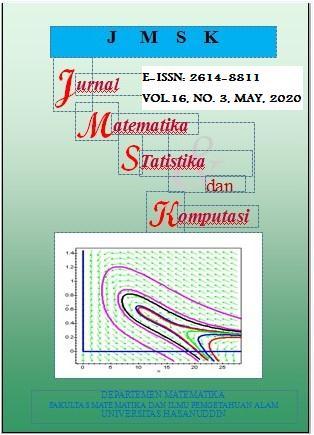Service Waiting Time Behavior of Express Maintenance (EM) Program of PT. Dunia Barusa Banda Aceh
DOI:
https://doi.org/10.20956/jmsk.v16i3.4927Keywords:
CDF, express maintenance (EM), PDF, service waiting time, survival and hazard functionAbstract
Survival analysis is a statistical method that can be used to analyze duration time data of an event occurrence. This research uses secondary data from PT. Dunia Barusa branch Banda Aceh that collected from January to March 2017 which amounted to 107 data. The data is service waiting time (in minutes) of Express Maintenance (EM) program on sub section receptionist, service, final inspection, confirmation, technical complete, invoicing, customer notification and delivery. There are 4 functions analyzed, namely density probability function (PDF), cumulative distribution function (CDF), survival and hazard function. The study shows that the probability of a customer being in the waiting process of service tends to become smaller as the service waiting time become longer on each sub section of the EM program, as well as the probability to remain in the waiting process after the customer has been there within a certain period of time indicated by the survival function. The hazard function shows that the rate of a customer will be served instantaneously in the sub section receptionist, service, invoicing, customer notification and delivery changing over the time, while in the sub section of final inspection, technical complete and confirmation, the rates are constant over the time as high as 0.757, 0.794, and 3.336 respectively.
References
Kuntari, B. D., Kumadji, S., & Hidayat, K., 2016. Pengaruh Kualitas Pelayanan Terhadap Kepuasan dan Loyalitas Pelanggan (Survei Pada Pelanggan Bengkel PT Astra International Tbk – Daihatsu Malang). Jurnal Administrasi Bisnis, Vol. 36, No. 1, hal. 196–202.
Anwar, S., Afriyani, A., Ula, P. S., Safriana, I., Fajri, I., & Ariska, R., 2017. Visitor Behavior in the Library of Syiah Kuala University based on Their Visiting Time Duration. Eksakta: Jurnal Ilmu-Ilmu MIPA, Vol. 17, No. 2, hal. 119–136. https://doi.org/10.20885/eksakta.vol17.iss2.art4
Kleinbaum, D. G., & Klein, M., 2012. Survival analysis : a self-learning text, Third edition. Springer Science Business Media, Inc., New York.
Anwar, S., Ahya, D., Afriyani, A., Nurhidayati, N., Ariska, R., Wahyudi, R., & Iswani, N., 2017. Analisis Waktu Pelayanan Penerbitan Izin Gangguan (HO) Dinas Penanaman Modal dan Pelayanan Terpadu Satu Pintu (DPM PTSP) Kota Banda Aceh. Jurnal Matematika Integratif, Vol. 13, No. 2, hal. 133 142. https://doi.org/10.24198/jmi.v13.n2.12785.133-142
Anwar, S., Salsabila, I., Sofyan, R., & Amna, Z., 2019. Laki-Laki atau Perempuan, Siapa yang Lebih Cerdas dalam Proses Belajar? Sebuah Bukti dari Pendekatan Analisis Survival. Jurnal Psikologi, Vol. 18, No. 2, hal. 281–296. https://doi.org/10.14710/jp.18.2.281-296
Anwar, S., Afriyani, A., Ahya, D., Nurhidayati, N., Iswani, N., Ariska, R., & Wahyudi, R., 2017. Analisis Faktor yang Mempengaruhi Lama Waktu Pembayaran Angsuran Pertama Program ZIS Produktif Baitul Mal Aceh. STATISTIKA: Journal of Theoretical Statistics and Its Applications, Vol. 17, No. 2, hal. 53–61. https://doi.org/10.29313/jstat.v17i2.2697
Collett, D., 2003. Modelling Survival Data in Medical Research, Second edition. Chapman and Hall, London.
Lee, E. T., & Wang, J. W., 2003. Statistical Methods for Survival Data Analysis, Third edition. John Wiley & Sons Inc., New Jersey.
Zacks, S., 1992. Introduction to Reliability Analysis : Probability Models and Statistical Methods. Springer, New York.
Rausand, M., & Høyland, A., 2004. System reliability theory: models, statistical methods, and applications, Second edition. John Wiley & Son, Hoboken.
Hogg, R. V., & Tanis, E. A., 2010. Probability and statistical inference. Pearson Prentice Hall, New Jersey.
Stasinopoulos, M., Rigby, B., & Akantziliotou, C., 2007. Instructions on how to use the GAMLSS package in R, Second edition. Technical Report 01/08, STORM Research Centre, London Metropolitan University, London.
Downloads
Published
How to Cite
Issue
Section
License

This work is licensed under a Creative Commons Attribution 4.0 International License.
Jurnal Matematika, Statistika dan Komputasi is an Open Access journal, all articles are distributed under the terms of the Creative Commons Attribution License, allowing third parties to copy and redistribute the material in any medium or format, transform, and build upon the material, provided the original work is properly cited and states its license. This license allows authors and readers to use all articles, data sets, graphics and appendices in data mining applications, search engines, web sites, blogs and other platforms by providing appropriate reference.







